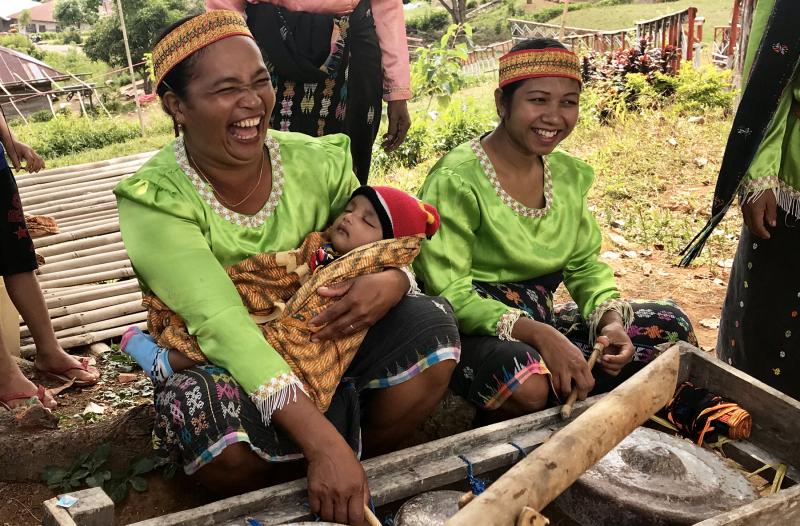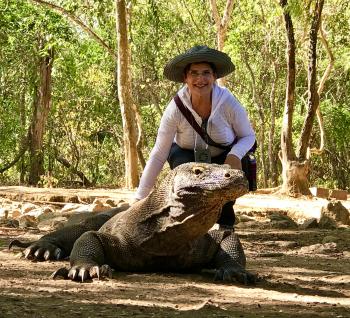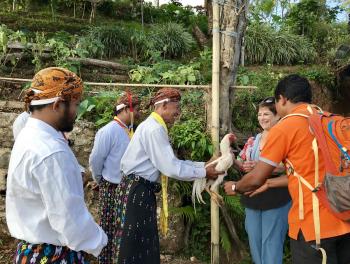An Indonesian journey continues with visits to the islands of Bali and Komodo (Second of two parts)
This article appears on page 20 of the May 2019 issue.
Following time on the Indonesian islands of Borneo and Java, my June 2018 tour with Overseas Adventure Travel, or OAT (Boston, MA; 800/955-1925, www.oattravel.com), continued to Bali.
A festive atmosphere
We arrived in the middle of the exciting Galungan celebration, and I was speechless seeing the number of temples and shrines each family had… inside their homes, in their offices, in the local park — everywhere. At each one of these, someone placed a basket of offerings twice a day, which we had to sidestep as we entered many establishments.
We became “students” of Balinese dancing at a children’s dance school, where we joined the skilled dancers as they performed. As we watched and tried to emulate the bent-finger hand positions and eyes looking up and down, we quickly realized how difficult it was.
In Candidasa, Bali, the festival preparations were in full swing. (A great thing about OAT is that they will stop to become involved in an “unplanned” cultural happening, which is what I love most about travel.) Erected outside many Balinese homes the day before the start of Galungan, elaborately decorated, stories-high, swaying bamboo poles known as penjors could be seen everywhere.
We drove through rural villages on the southern slopes of Mount Agung on the way to visit blacksmiths and a Balinese ikat textile maker, all the while keeping our eyes on the volcano.
As we enjoyed a picturesque lunch at Tirta Gangga, a former royal summer residence, we began to see smoke in the near distance. It was on our minds every day, and it started to frighten me. (Right after I arrived back in Napa, in July, Mt. Agung started to erupt, sending a massive plume of ash skyward.)
In Kusamba, a coastal village known for its black-sand beach, I was fascinated watching an older man make some of his hundreds of trips a day to carry salt water from the ocean. Using his homemade invention, he processed the water to provide salt to the entire community. His agility and strength were awe-inspiring.
He pointed at me, a volunteer, to work the mechanism to cull the salt from the sand. Of course, I never say “No.” A bag of his salt is now sitting in my kitchen.
Jumping in
The highlight of my trip was yet to come. We traveled to the Sudamala Purification Temple, where a Hindu priest conducted a purification ceremony using ice-cold rushing water from the temple’s holy springs.
This was especially spiritual because of the significance of the Galungan holiday. Some of us jumped in, fully engaged in the wet purification experience.
We had to go through all seven roaring springs that were pouring out from the mountain. The roar and power of the rushing water was frightening, but I felt serene and, personally, fulfilled.
Finally, the priest gently placed grains of rice on our chests and foreheads after we received his blessing.
We climbed out of the water trepidatiously and walked over to another temple, where we all partook in a dry purification ceremony, which ended with the Hindu priest tying a ceremonial bracelet on each of us. I still have mine on, though it’s a bit raggedy.
We continued on to Ubud, Bali‘s artistic heart, where I was able to spend quality time visiting my good friend Connie Jones, an expat who now makes her home in Ubud.
In the 1920s, Ubud grew from a sleepy but charming village into a nucleus for the arts. The scenic rice fields, hills and streams surrounding the town enticed European painters to settle there, and an influx of arts funding resulted. Today, it’s a bustling, full-of-tourists city, with lots of charm.
We visited a coffee plantation to learn about the cultivation process of kopi luwak, or civet coffee. Often called the world’s most expensive coffee, it consists of partly digested coffee cherries that have been eaten and the beans expelled by the Asian palm civet, an unusual “cat,” before being collected, cleaned and roasted.
On our next adventure, the group set out for the Kintamani Volcano area to visit the village of Trunyan, crossing Lake Batur by motorboat. Trunyan is home to the Bali Aga ethnic group, known for their ancestral rituals. It is one of the oldest villages in Indonesia, and, contrary to Balinese tradition, the people of Trunyan do not practice cremation but display their dead in open graves concealed by bamboo lattices.
Because of limited space in their tiny cemetery (reachable only by boat), skulls are removed and stacked as new bodies are moved in along with the fresh daily offerings of flowers, dishes and items significant to the deceased.
Visiting this isolated village was like taking a step back in time.
Early one morning, before the heat would oppress, we all took a long walk through the well-known, amazing Campuhan Ridge. Our timing was perfect. Rice harvesters were in full force, and I had a chance to jump in and learn how to beat the rice to allow the kernels to fall. Laughing, the sun-protected cloth-wrapped ladies patiently showed me how, and then they quickly relieved me of my task.
A look at traditions
In Bali, we also visited the workshop of a puppet master and his son, who was learning to continue the art of puppet making and puppetry in his family (another disappearing art). We were told that most young people of today are not interested in learning Bali’s traditional crafts and preserving the ancient arts.
The puppet master then treated us to a short performance, with lots of shouting and overemphasized expression, while simultaneously banging drums emphatically with his foot under the curtain. It was all very dramatic.
Another really exciting day had us all piling into open jeeps and heading for the village of Jatiluwih. The prolific rice fields there have been designated a UNESCO World Heritage Site because they exemplify the traditional Balinese community’s ingenious irrigation system known as Subak. We stopped to interact with the hardworking harvesters, who smiled and invited us to help.
Continuing our drive, our two guides, Rupa and Emanuelle, spotted a traditional Balinese preparation for cremation gathering along the way, so they detoured from our route and stopped.
The tiered resting place for the deceased was waiting outside the house, while inside, the entire community was there, preparing the body. Everyone welcomed us as we walked into this ritualistic ceremony.
Eventually, the body was to be carried outside and placed on the beautifully decorated bier; it would then be cremated.
It was yet another door that opened for us to experience Balinese cultural traditions, and it was truly amazing.
We continued through the countryside to Ulun Danu Beratan, a 17th-century island temple that appears to float over Lake Bratan.
Balinese Hinduism is sometimes known as the “religion of the holy water“ for the important role that water plays in its rituals, and this temple is dedicated to the goddess of the lake, Dewi Danu.
Village life
As a group, we had a rare opportunity to experience “a day in the life” of the residents of the rural hills outside of Lovina. Our first task was to go to a local market in small groups — in the bustling morning hours — to purchase, with the small amount of Indonesian rupiah we were given, some of the unusual fruits and vegetables that thrive in the north of Bali and deliver them to the family who was going to help us cook our lunch in the village that day. The village is totally self-sustaining; everything they need is either grown or raised or made on the mountain.
Way up in the hills, we became part of the fabric of the farming community of Tiga Wasa. We “experienced” village life — from observing a woman high in a tree collecting fruit to visiting the home of the village healer, where the community chief was presenting offerings in exchange for the healer’s services. The significance of every item in the offering trays and the respect shown to the healer were truly touching.
The healer is also a musician, and he entertained us while his wife of many years, a dancer, observed.
We learned how to weave bamboo, feed the cattle and create the sacred offerings. We all were fascinated as we watched the aging patriarch shimmy up a tall tree, which he does four times a day to collect the sap from which a special alcoholic beverage called arak is distilled. (It’s also made into bricks of very sweet, caramelized palm sugar, which they sell.)
We all worked with the women of the extended family that was hosting us as we created an offering basket and a traditional Balinese multicourse open-air lunch, steeped in regional herbs and spices, at their rustic home on the mountain.
At the end of our visit, as we trekked back to our jeeps, we stopped at one of the many homes on the mountain, where a little, mischievous boy released all the family’s pigeons from their coop. I was handed some pigeon food and was immediately engulfed by about 50 pigeons — one of those travel moments that made me feel pure happiness and joy!
Animal encounters
Before sunrise, we boarded several Denpasar “spider boats” to follow some dolphin pods as they frolicked. We had so much fun as we competed with each other to be the first spotter.
The next morning, three of us arose before sunlight once again and were taken to the local park where it seems everyone exercises before the heat descends. We learned how to play a Korean version of bocce/croquet and made friends with the local competitive teams.
The “illegal” street food we found outside the park (a local woman selling food from an ice chest) was the best-tasting food I had had in Indonesia to that point. (For me, the food was not one of the high points on this trip.)
Our last exciting Balinese adventure was a visit to Pura Luhur Uluwatu, or Temple Above the Headstone. Dating to the 10th century, it is a striking example of a Balinese sea temple, perched on a cliff 230 feet above the water.
Hiking up to the top in the intense sun, we had several hysterical interactions with the “naughty” macaque monkeys. Warned about their mischievousness, we were advised to not wear glasses, jewelry, hats, purses or anything that could be grabbed, as they can be fast and aggressive.
One of the women in our group got clunked in the head and then her hat was ripped off and the perpetrator was gone. Another young girl’s sandal was stolen as she was walking! Roving workers carry slingshots and packets of food to distract a monkey “thief,” who drops the ill-gotten goods because it needs both hands free to grab the two packets of food the ranger throws at it. Ingenious!
Komodo and beyond
Our tour guide, Em, saved the best for last. If anything could compete with Borneo’s free-running orangutans and Bali’s festivals, it was the storied Komodo dragons of Indonesia.
After we landed in Labuan Bajo on the island of Flores, boats were ready to whisk us to Komodo island, a UNESCO Site. Like Australia, Komodo was first settled as a penal colony, but the descendants of its first settlers are now avid fishermen.
The existence of the island’s “dragons” was first reported 200 years ago, but naysayers denied their existence until the 20th century. In actuality, they are more accurately described as monitor lizards.
Led by a ranger through the island’s flora and fauna, we were constantly on the lookout for the dragons. They are not confined; the island is theirs. Their hearing is acute, so we had to tread softly and not talk.
All of a sudden, the first scaly giant waddled across our path. Scared out of my wits, I got as close as allowed and videotaped his movements and sounds as he lumbered down the road.
The adept ranger/guide helped us find many more, each sighting more thrilling than the other. The only weapon he had to protect us was a long, forked stick to distract them from getting too close.
We also discovered the island’s other unique feature: pink sand. One of only a handful of pink-sand beaches on Earth, this shoreline is colored by foraminifera, living single-celled marine organisms that turn the sand a reddish color. When the red shells of the foraminifera and the pure-white beach sand are tumbled together by the tide, the resulting blend is a brilliant pink.
Fortunately for us, there was not a soul on the beach for the hours we were frolicking in the turquoise waters, snorkeling (sunburn city!) and enjoying a relaxing picnic on the beach. It was a perfect day.
An intriguing interaction
Since part of the fabric of Overseas Adventure Travel tours is to get up close and personal with the local people, we spent this day getting to know what life on the island of Flores is like with a visit to Cecer Village, where the clan-based Manggarai speak their own dialect. Their numbers have dwindled in recent years, and the elders are working hard to preserve their culture.
Our group voted that I would be their representative to the chief. In a formal ceremony outside the ceremonial hut, I presented our group and gave him the ceremonial money.
Without prior mention to our guide, they handed me a live, squirming chicken. After a few minutes in my arms, as the chief continued with the ceremony, the chicken was not happy and it covered me with scratches. Not knowing what to do, since I didn’t want to offend the tribal council, I thrust out my arms, handing the recalcitrant chicken back to the chief.
The ceremony continued with traditional songs and arak sharing as I sat cross-legged on the mat floors, facing the chief and the tribal council, while the others in our group respectfully observed. I felt like I was in a scene from a movie and the director was going to yell “Cut!” at any moment. It was surreal.
As we continued our walk through the village, we stopped for a look inside the villagers’ homes and talked to them about their cultural practices and seasonal crops. Through these interactions and talks with the locals, we enjoyed a richer understanding of village life and Manggarai culture.
Next, some of us who didn’t mind being in small, humid, dark spaces and were able to crawl through spaces which were only 3 by 2 feet wide ventured into the recently discovered Batu Cermin Cave. A couple of people got halfway through and then went back, and several people were freaked out and didn’t even start. Even though bats were hanging above our heads and the heat and humidity were stultifying, I made it.
Our final adventurous day began on a large, handsome wooden boat. We lazily motored for hours to Rinca, an island few Americans visit. Smaller than Komodo and even more unspoiled, this is the best locale for having a chance to witness Komodo dragons in their natural habitat.
As the dragons are protected by law, a ranger must accompany groups as they look for the mighty creatures, the longest lizards on Earth, often growing to a length of 10 feet.
Some of the lizards were indolently lying on the ground with bulging stomachs, having been recently fed. Though they would remain motionless for days until their hunger returned, they were still scary, so we gave them a wide berth. (Unwitting villagers have been killed on the island in surprise attacks.)
During our leisurely 2½-hour boat ride back through the gentle turquoise waters, we had lots of time to relax, eat amazing food prepared by the superb onboard chef and swim or snorkel in the crystal-clear water. It was an immensely satisfying end to an enlightening journey.
Overseas Adventure Travel’s pricing for 2019 departures starts at $695 per person for the 3-night Hong Kong stopover, $1,895 for the 4-night “Borneo’s Rain Forests & Orangutans” pre-trip extension, $3,095 (land only) for the 15-day “Java & Bali: Indonesia’s Mystical Islands” tour and $1,645 for the 5-night “Komodo Island & Beyond” post-trip extension. Prices vary based on single or double occupancy and departure date.
**Please note the correction regarding this article.



